Virginia Groundcherry, Ground Cherry, Lanceleaf Groundcherry, Hog Plum, Husk Tomato - Physalis virginiana
|
Physalis virginiana - Virginia Groundcherry, Ground Cherry, Lanceleaf Groundcherry, Hog Plum, Husk Tomato. There are 29 species of Physalis found in the United States in 2012 according to the USDA Plants Database. At least one species is found in every state except Alaska, although neither of the species found in Hawaii (P. philadelphica and P. peruviana) are native to the United States. The species presented here, Physalis virginiana, is one of the more widely distributed species, being found throughout the middle and eastern United States and Canada except for Florida, Rhode Island, New Brunswick, and Nova Scotia. It is classified as Endangered in New York, Ohio, and Pennsylvania.
Found in:
AL, AR, CO, CT, DE, GA, IA, IL, IN, KS, KY, LA, MA, MD, ME, MI, MN, MO, MS, NC, ND, NE, NH, NJ, NM, NY, OH, OK, PA, SC, SD, TN, TX, VA, VT, WI, WV, WY
Leave comments on Physalis virginiana at this link. | 
Distribution of Physalis virginiana in the United States and Canada:

Map courtesy of The Biota of North America Program.
Map color key
Search Our Database: Enter any portion of the Scientific, Common Name, or both.
Do a general Google search of the entire site:
#ad
 Follow USWildflowers on Twitter
#ad
| | Site: Walker County, GA Date: 2012-June-17 | Photographer: Gerald C. Williamson
Nikon D7000
Tamron AP AF 90MM Macro | | The yellow VIrginia Groundcherry flower dangles below a five-lobed calyx which is covered with very small hairs. Similar species Physalis longifolia normally has a glabrous (hairless) calyx, and Physalis pubescens is quite hairy. | | 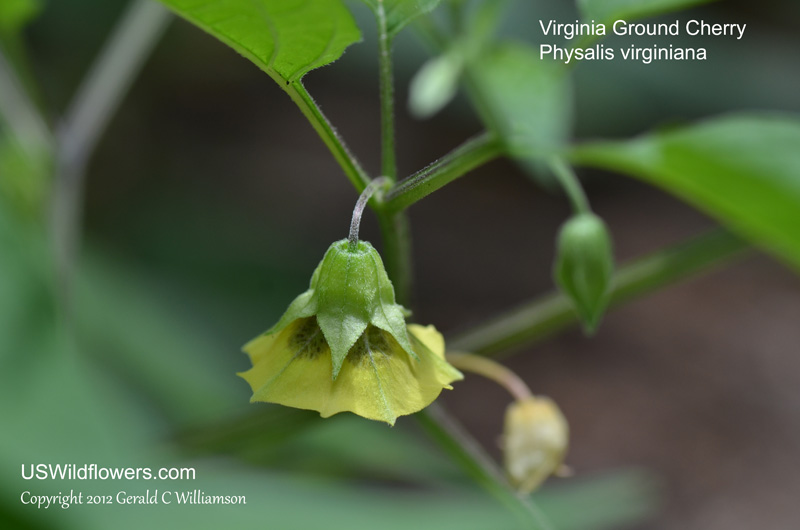
| | Site: Walker County, GA Date: 2012-June-16 | Photographer: Gerald C Williamson
Nikon D7000 | | Each of the 5 petals of the flower have a brownish-purple marking inside near the base. | | Click on the photo for a larger image
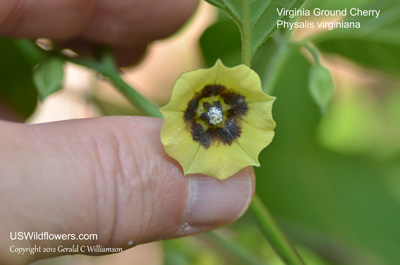
| | Site: Walker County, GA Date: 2012-July-01 | Photographer: Gerald C Williamson
Nikon D7000 | The calyx becomes a papery capsule which encloses the fruit that becomes red-orange and is edible when ripe. As with most of the plant, it has short, usually curved hairs.
Caution: the rest of the plant and the unripe fruit is poisonous, as is the case with many members of the Solanaceae family. | | Click on the photo for a larger image
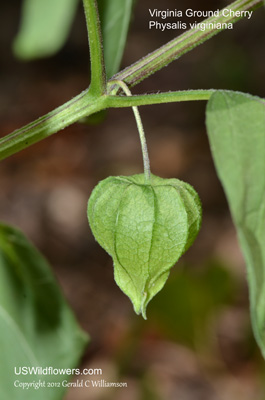
| | Site: Walker County, GA Date: 2012-October-14 | Photographer: Gerald C Williamson
Nikon D7000 | | The fruit inside the papery capsule - green in this photo, but showing tinges of the reddish color it will become when ripe. | | Click on the photo for a larger image
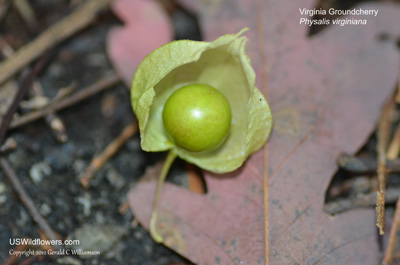
| | Site: Walker County, GA Date: 2012-June-17 | Photographer: Gerald C Williamson
Nikon D7000 | | The alternate leaves of Virginia Groundcherry are ovate to lanceolate, and are usually more than 1.7 times as long as they are wide. They may be toothed or entire, and up to about 4 inches long. The plant can be up to about 2 feet tall. | | Click on the photo for a larger image
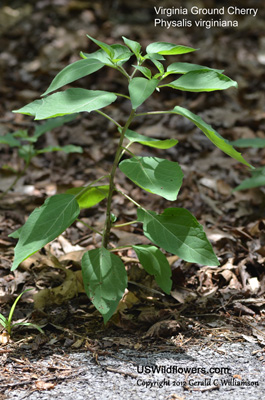
| | Site: Walker County, GA Date: 2012-June-17 | Photographer: Gerald C Williamson
Nikon D7000 | | The leaves of Physalis virginiana yield a very narrowly winged petiole. The examples I’ve seen have mostly had the leaf narrow more abruptly on one side than the other. | | Click on the photo for a larger image
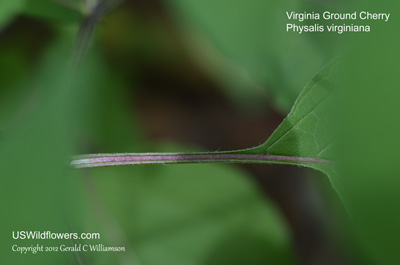
| | Site: Walker County, GA Date: 2014-December-02 | Photographer: Gerald C Williamson
Nikon D7000 | | Dried seed capsule | | Click on the photo for a larger image
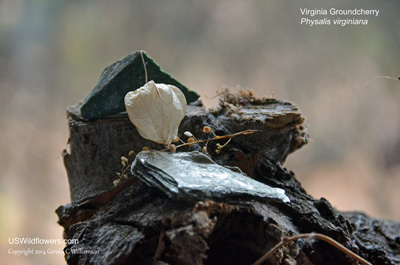
|
References used for identification and information:
|
|
| |
| #ad
|
|









